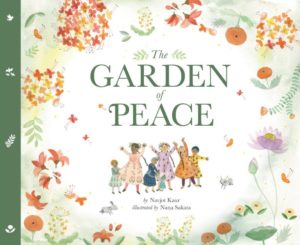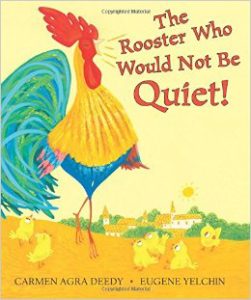In eras of censorship children’s stories, written as fables and often featuring animals, have offered messages of resistance and a set of alternative values – ones of justice, equality, freedom and inclusion. Whether these picture book fables will soon challenge the primacy of a smug post-modernism remains to be seen, but two recent titles – one from the small Canadian publisher Saffron Press and one from children’s publishing giant Scholastic – offer hope. Each of them begins with the arrival of an oppressive regime and show animals and people ultimately working together to create positive change.
 Navjot Kaur’s The Garden of Peace, illustrated by Nana Sakata and published by Saffron Press, draws on Sikh teachings in its celebration of nature and diversity. The story begins with the planting of five seeds at a time of great oppression: “Elders and little ones wondered if the seeds would ever grow. Few held out hope.” Just as the strongest and tallest plants crushed the smaller ones, rulers and their wealthy allies occupied the best lands and left the common people to fight for the remains. The powerful sowed fear of both weeds and the poor.
Navjot Kaur’s The Garden of Peace, illustrated by Nana Sakata and published by Saffron Press, draws on Sikh teachings in its celebration of nature and diversity. The story begins with the planting of five seeds at a time of great oppression: “Elders and little ones wondered if the seeds would ever grow. Few held out hope.” Just as the strongest and tallest plants crushed the smaller ones, rulers and their wealthy allies occupied the best lands and left the common people to fight for the remains. The powerful sowed fear of both weeds and the poor.
One day, the birds brought five misshapen seeds to the Garden of Anandpur, and the villagers followed, anxious to find out if the seeds would sprout. The migration to see the seeds was also a migration away from the poverty and terror of their home. Initially disappointed, the villagers listened as some among them urged them toward hope – to give the seeds a chance. Among their new leaders were Himmat “the untouchable one” as well as shopkeepers, farmers, craftspeople, and Sahib, a “warrior for change.” Working together, the migrants got the seeds to bloom, as they realized, among other things, that each person has something to contribute, and “weeds were plants too.”
Kaur’s text deftly parallels nature and human society, giving readers much to think about and expanding the curricular reach of The Garden of Peace. In addition, the story presents the origins of the Sikh religion and can spur further exploration and comparison of belief systems. The watercolor illustrations balance vignettes with two-page spreads, and among the spreads is a useful map of South Asia that shows the location of the Garden of Peace and the places where Sikhism originated. A lovely final surprise is the final end papers that illustrate the various “Citizens of Change”: the free thinker, the storyteller, warriors of change, the poet, the melody maker, and the dream chaser. Through this picture and the text, children can identify the talents that will help them bring about change.
 The author and the illustrator of The Rooster Who Would Not Be Quiet! are no strangers to repression. Carmen Agra Deedy was born in Cuba, and Eugene Yelchin, the author/illustrator of the Newbery Honor book for middle grade readers Breaking Stalin’s Nose, grew up in the former Soviet Union. In this collaboration between Deedy and Yelchin, the people of La Paz (a village that could be anywhere in Latin America or Spain) elect their dictatorial mayor after firing his predecessor for allowing the village to become too noisy. (After all, La Paz means “peace.”) The new mayor promises to reduce the noise level, but it’s a slippery slope before no noise at all is permitted. Some leave, but most accept the new, quiet reality.
The author and the illustrator of The Rooster Who Would Not Be Quiet! are no strangers to repression. Carmen Agra Deedy was born in Cuba, and Eugene Yelchin, the author/illustrator of the Newbery Honor book for middle grade readers Breaking Stalin’s Nose, grew up in the former Soviet Union. In this collaboration between Deedy and Yelchin, the people of La Paz (a village that could be anywhere in Latin America or Spain) elect their dictatorial mayor after firing his predecessor for allowing the village to become too noisy. (After all, La Paz means “peace.”) The new mayor promises to reduce the noise level, but it’s a slippery slope before no noise at all is permitted. Some leave, but most accept the new, quiet reality.
Seven years later, “a saucy gallito and his family” come to town. Unaware of the noise prohibition – and not caring – the rooster does what roosters do: crow at all hours of the night and day. The despotic mayor cuts down the rooster’s favorite mango tree, throws the rooster in a cage far from his hen and chicks, puts a blanket over the cage so the creature can’t tell day from night, and ultimately threatens to make rooster soup. But as the rooster stands up for his right to crow, he mobilizes the previously passive villagers, so that in the end, in the his words, “a song is louder than one noisy little rooster and stronger than one bully of a mayor…And it will never die – so long as there is someone to sing it.”
Once again, an animal inspires change, showing us that nature seeks freedom, and a love of freedom – and of song – is part of human nature as well. The brave rooster also serves as a stand-in the millions of freedom-seeking people all over the world throughout history who endured deprivation, imprisonment, and torture – many of them paying the ultimate price – to express themselves and to make it possible for others to speak. Yelchin’s bright mixed-media paintings contrast the lively rooster with the villainous mayor whose human characteristics (for instance, turning green with indigestion at the endless crowing) foreshadow his humiliation at the hands of the people who first granted him the power to terrify and silence.
1 comment for “Fables for Our Time: The Garden of Peace and The Rooster Who Would Not Be Quiet”